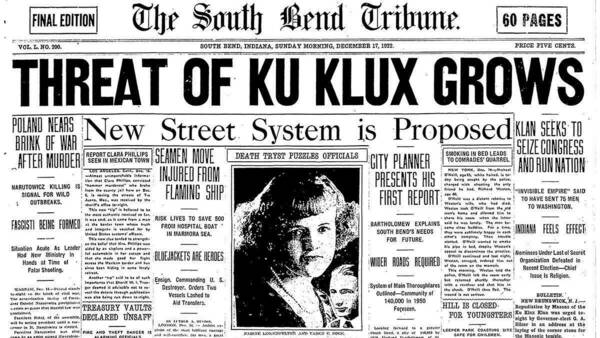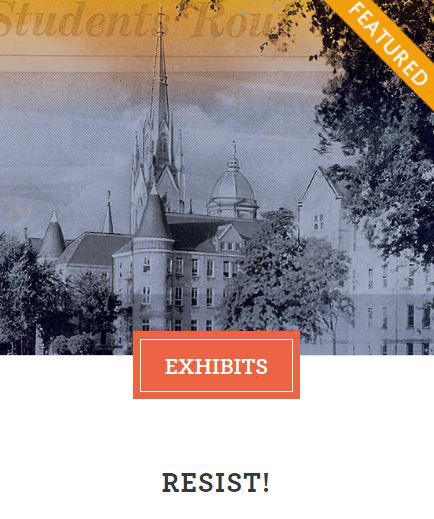
One hundred years ago next month, amid a rise in right-wing xenophobia in the United States, hundreds of University of Notre Dame students marched into downtown South Bend to confront the Ku Klux Klan, leading to an exchange of words and fists and marking a pivotal moment in Indiana history.
That moment, previously recounted in author and alumnus Todd Tucker’s book “Notre Dame vs. The Klan,” is the focus of an upcoming exhibit about the rise and fall of the Ku Klux Klan in Indiana, where the group shot to power in the early 1920s.
“RESIST!,” presented by Notre Dame, the Herbert Simon Family Foundation and the Efroymson Family Fund with support from the Ruth Lilly Philanthropic Foundation and the Ackerman Foundation, opens Saturday (April 13) and runs through Aug. 2, 2025, at the Eugene and Marilyn Glick Indiana History Center in Indianapolis.
A “sister” exhibit, presented with support from The History Museum, will open May 17 and run through Oct. 13 at the St. Joe County Public Library in South Bend — in a windowed room overlooking the intersection where the primary clash between the students and Klansmen took place.
“As we mark the moment 100 years ago when Notre Dame students joined with members of the local community to defend religious freedom and reject hate, we reflect on the bravery of those men and women who stood tall in defense of the principles upon which both Church and country were founded — namely, respect for the dignity and humanity of all people, regardless of background.
In both locations, voice actors portraying students and others will provide accounts of the incident, real and fictionalized, as part of an immersive audio-visual experience — just one of many unique aspects of the exhibit.
“This is such a powerful story to tell, and an important moment in Indiana’s history,” said Jody Blankenship, Indiana Historical Society president and CEO. “Our goal is to help visitors understand how Hoosiers fought discrimination and hate in Indiana through this pivotal event and the context that surrounded it. Our hope is that visitors come away with not just more knowledge of the past, but also with a better understanding of how these lessons inform our future.”
Pedro Ribeiro, vice president for public affairs and communications at Notre Dame, said, “As we mark the moment 100 years ago when Notre Dame students joined with members of the local community to defend religious freedom and reject hate, we reflect on the bravery of those men and women who stood tall in defense of the principles upon which both Church and country were founded — namely, respect for the dignity and humanity of all people, regardless of background. To that end, we are proud to join with the Indiana Historical Society and The History Museum to mark this pivotal moment in Indiana and Notre Dame history. As former University President Theodore M. Hesburgh, C.S.C., wrote, ‘Our words are buttressed by our deeds, and our deeds are inspired by our convictions.’ May the words and deeds of those who rejected hate and bigotry in the past inform and inspire us today."
Inspired by the pioneering silent film “The Birth of a Nation,” which cast the Klan as defenders of “American” (i.e., white, Protestant, Anglo-Saxon) values, the Klan rode a wave of nativist sentiment to renewed prominence in the 1920s after years of irrelevance following Reconstruction.
By the mid-point of the decade, the group controlled nearly every lever of power in Indiana, where, under the leadership of notorious Grand Dragon D.C. Stephenson, it leveraged control of the Republican party to infiltrate state and local offices from the governor’s office on down.
The group used violence and inflammatory rhetoric to attack and marginalize not only Blacks, Jews, immigrants and other “outsiders,” but also Catholics, whom they viewed as loyal to the Vatican above the United States.
It was around this time, in May 1924, that the group announced plans for a picnic and parade in South Bend, determined to showcase its power and secure its grip on state and local politics in the most Catholic area of the state — home to one of the most renowned institutions of Catholic learning in the U.S.
But as the parade was getting underway on the afternoon of May 17, 1924, a group of about 500 Notre Dame students, responding to reports of hooded men directing paradegoers in the city, raced from campus to downtown — a distance of more than a mile — to confront the Klansmen in person.

Covertly at first and then with increasing brazenness, the students, as well as other “anti-Kluxers,” harassed and unmasked the Klansmen and chased them back to the group’s headquarters — a Victorian-style commercial building at the northeast corner of Michigan and Wayne streets in downtown South Bend, kitty corner from the present-day library.
There, the students gathered potatoes from a downstairs grocery store and took aim at a “fiery cross” — a wooden cross illuminated with red light bulbs — hanging from the group’s third-floor office window, shattering both the cross and the window.
At one point, a group of about 100 men charged up the stairs of the building, only to be marched back down at gunpoint by one J.H. Horton, a preacher who, common to the time, also served as the group’s leader and spokesman.
Eventually, cooler heads prevailed and the parade was allowed to proceed under negotiated terms. Due, however, to a combination of rain and public protest — as well as threats from the city to block the unauthorized procession — it was canceled.
In the end, the Klan never gained a serious foothold in the city.
Two years later, the group collapsed in scandal after Stephenson, who by that time had broken with the national Klan to form a rival organization in the Midwest, was convicted of rape and murder in the death of a young state employee, giving the lie to the group’s carefully crafted public image as defender of the law and morality.
Drawing from historical accounts, “RESIST!” will explore the incident from within the context of the social and political discourses and conflicts of the time — and in a manner that sheds light on broader themes and topics related to the Klan and its historic rise to power in Indiana.
It will also tell individual stories about resistance to hate throughout the state’s history.
Locally, the exhibit will include images and other artifacts exclusive to The History Museum, including a 1924 anti-Klan book and a 1920s photograph of a local parade float bearing the message, “River Park 100% KKK.” A window display will simulate the view from the library, had it existed at the time, circa May 17, 1924, with the damaged Klan headquarters across the street.
Visitors will also have the opportunity to visit nearby buildings and locations with a direct connection to the exhibit, such as the St. Joseph County Courthouse and the Jefferson Boulevard Bridge, where students first encountered the Klansmen before chasing them downtown.
“When the KKK tried to plan a rally to spread hate, Notre Dame students and local citizens resisted. This sister exhibit in South Bend brings an incredibly moving opportunity to learn this story while looking over the place where the bold confrontation happened,” said Brian Harding, The History Museum’s executive director. “We are proud to partner with the Indiana Historical Society and the University of Notre Dame to tell this story and honor all who continue to hold fast to the principles of equity.”
For more information, visit indianahistory.org/events/resist/.
Originally published by at news.nd.edu on April 11, 2024.